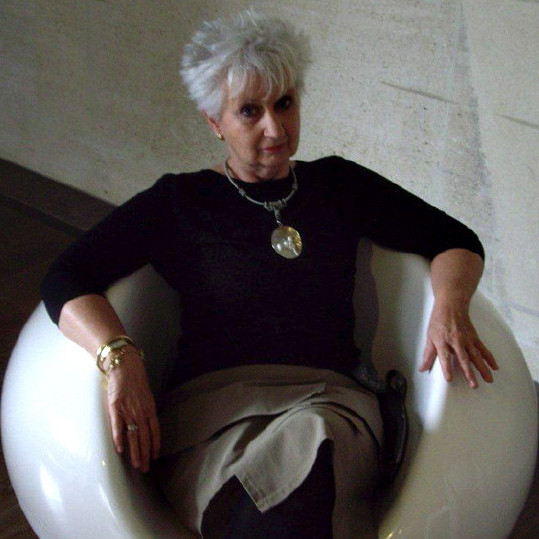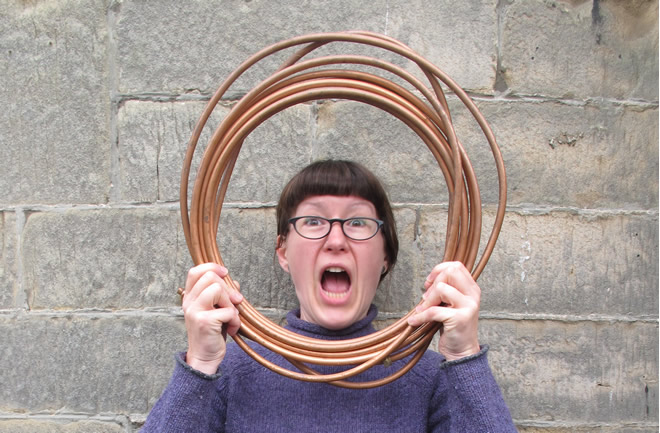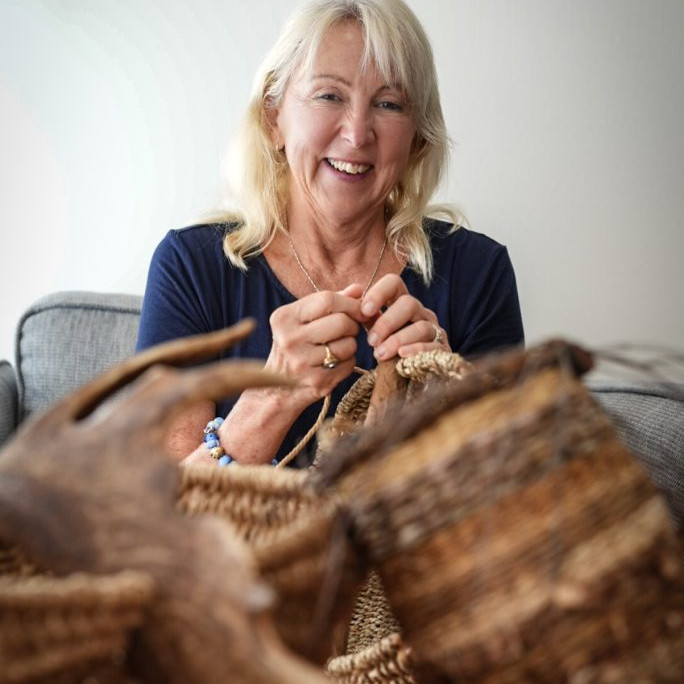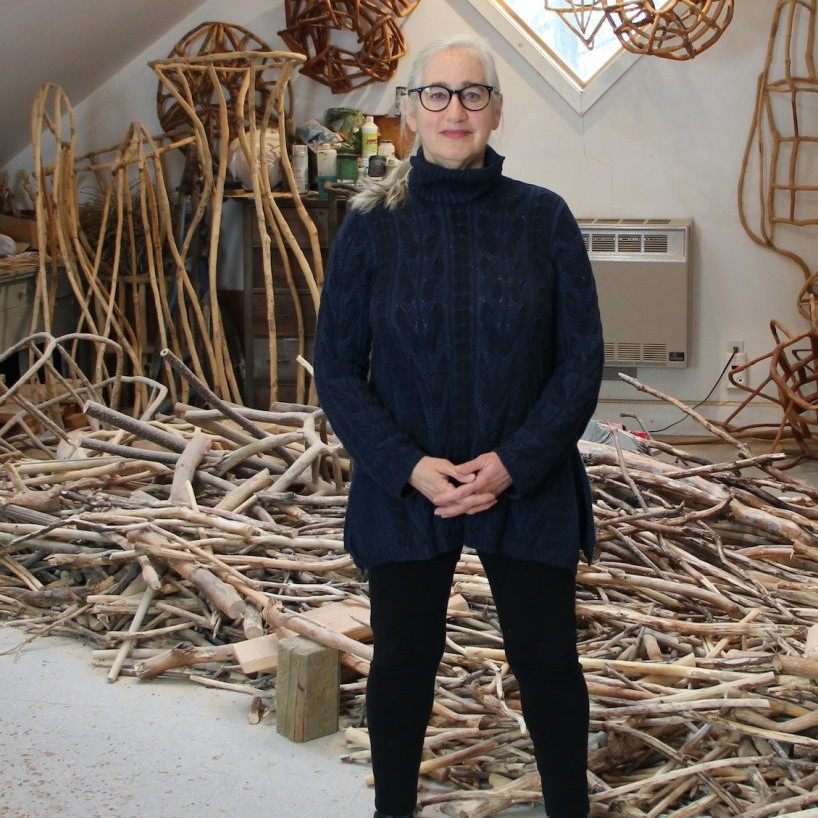Evie Milo Designer / Maker - Fife, UK
You began your journey with a box of vintage buttons – tell us briefly about this creative journey?
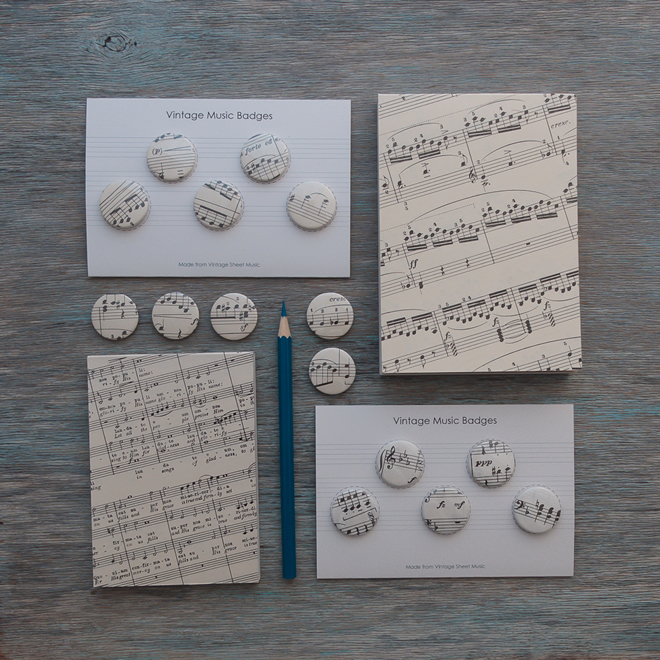
I say that and it is partly true but in reality my creative journey started when I was very young. I’ve always been creative and a bit of a hermit if I’m honest – even as a child I preferred to spend time on my own and create and draw. I remember my childhood as being quite practical and I was always constructing things and building stuff and digging and exploring. When I was a bit older I got into making my own jewellery and accessories from salvaged wire and beads donated by friends and relatives. I also knitted and sewed a lot too. We were immersed in the ‘make do and mend’ culture and I had a very inventive mother who could make anything go a long way and she re-used and re-invented things all the time and also she made most of my clothes too – a huge inspiration. I also had a very creative aunt who taught me how to crochet and knit and I remember spending lots of weekends at her house making different things – it didn’t really matter what the outcome was, so long as I was doing something with my hands I was happy.
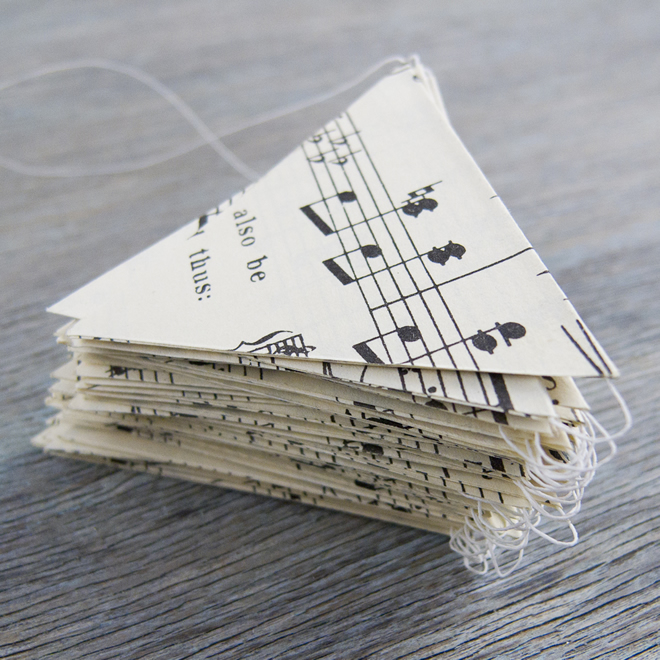
So I’ve always been a designer/maker at heart, it’s just taken me a long time to get round to doing what I love for a living. On this creative journey I’ve experimented, made mistakes, learnt lots of amazing skills and over the years have fined tuned them to suit what I do now. If someone had told my 10 year old self what I would end up doing for a living, I wouldn’t have believed them. I was being pushed down the academic avenue and at the end of the line was expected to enter into some kind of high paying profession. All along I knew this wasn’t for me and I fought against it by going to art college, then onto photography college and finally got into the design industry. I worked as an animator and web designer for over 15 years. I loved it but not only was I doing the 9-5, I was also creating and making the rest of the time and for a while found a happy balance between the two as I was self-employed and could decide my own hours.
It was only recently (4 years ago when my son was born) that I decided it was time to make a switch. I still do web design but only have one main client who keeps me very busy. My working hours are very flexible and this allows me the freedom to do Milomade the rest of the time and my working focus is now very much on my creative business.
The box of vintage buttons you refer to in your question was something I was fiddling about with when I was bed ridden with some sort of viral flu in 2008. Through this fiddling my elasticated button bracelet was born and that’s kind of when Milomade began too. These button bracelets have been going strong since then and I think I’d have to say they’re now my best seller. They form part of my Eco Chic collection of accessories with pieces made from vintage, recycled and new buttons mixed with leather, copper and cotton.
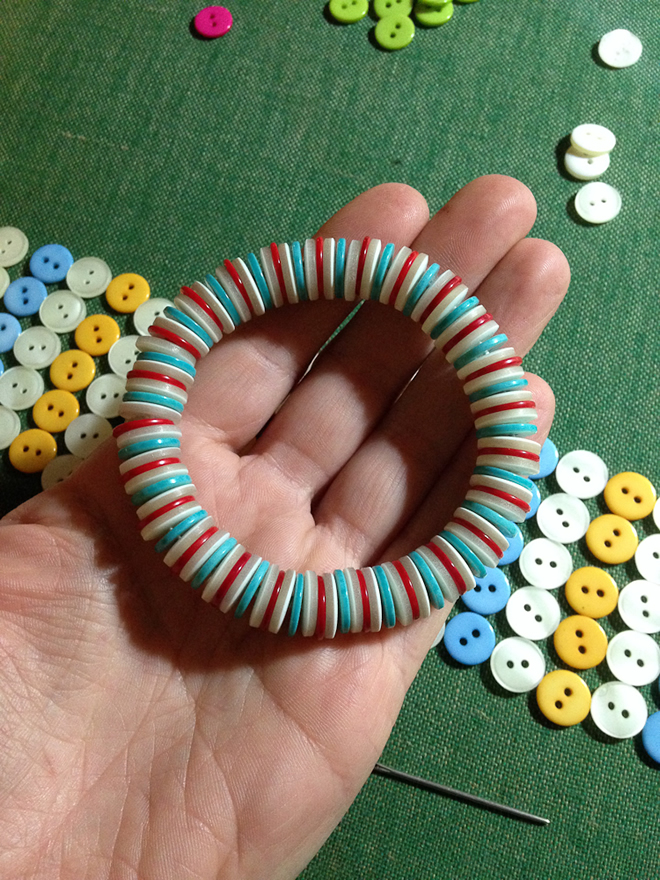
Only the funkiest and brightest buttons make it into the collection, which evokes the playfulness and nostalgia of our childhoods – the pieces suit young and old and all the ages in between. So many people say my Eco Chic bracelets look like sweeties and get a bit of a nostalgia kick when they wear them, as they’re reminded of the elasticated sweetie bracelets and necklaces they bought from the corner shop as children. Unfortunately, they’re not edible, but they are yummy in their own way!
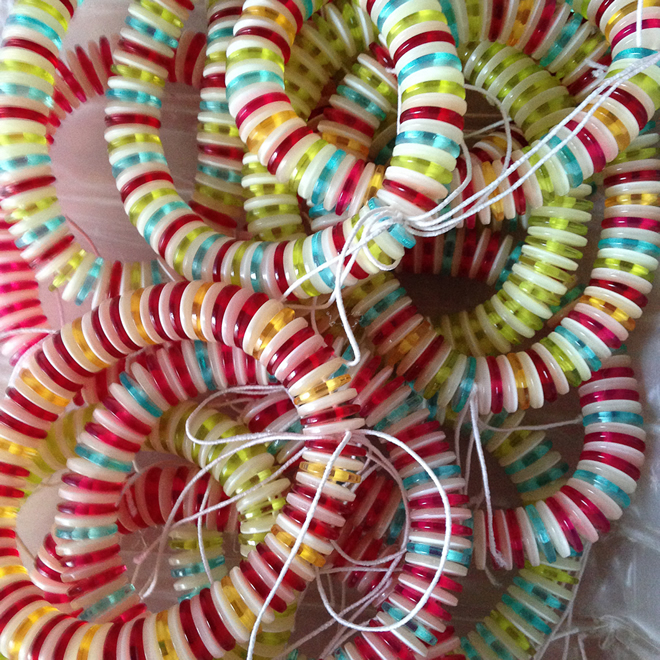
You describe yourself as a ‘Lost Property Inspector’. This is tongue in cheek, but quite close to the truth…
I’ve always been interested in the found object. A lot of my work at art college and sub sequentially at photography college has been based on found objects, found images and found texts. I guess it’s what I call the ‘lost property inspector’ within me that finds these things fascinating. I want to know where these things have traveled from, whether they were once cherished and lost, or unwanted and discarded? I want to know their stories and journeys. Take an old battered teaspoon for example – how many cups of tea has it stirred, by whom and what were the conversations it heard? I want to take these precious things in, cherish them and give them new life and new value.
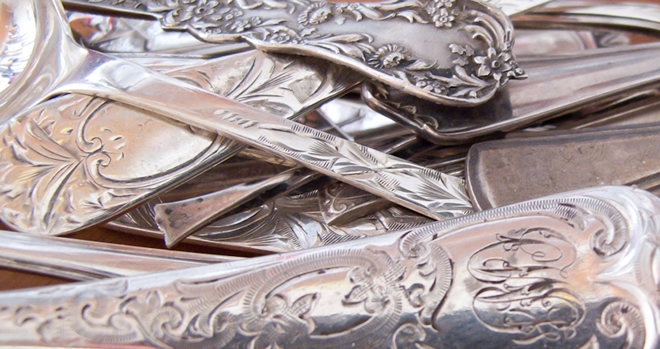
I live by the sea and walk on the beaches here every day and I’m constantly picking up fragments of pottery and sea glass as well as the odd set of teeth! You can find many a splendid thing on the beach and I think I’ve turned my son into a hoarder and collector already – he’s only 4! He calls it looking for treasure, and indeed I guess that’s what it is.
In my studio along with my jars of buttons I also have lots of jars of pottery shards, sea glass and random objects – I like giving these lost items a home. I make jewellery from sea glass, but it’s mostly on a commission only basis, but a collection is developing and I’m sure it will be launched in the next few years. I also have ideas of combining the pottery fragments with old B&W photographs and forming small silver brooches or lockets with these, but it’s just at the idea stage at the moment and therefore on the back burner until I have time to start developing the ideas further.
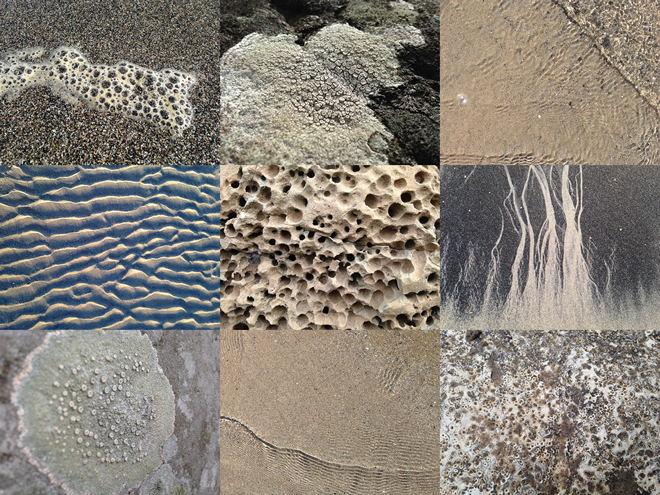
I love collecting things but when I started Milomade I never really thought about collections with regards to my products and just made lots of different things from recycled materials. Over the years though, and particularly recently, when I did my first trade show, I realized the importance of creating collections, especially with regards to jewellery as they keep the customer coming back for more. I had a lot of mentoring in the run up to my first trade show as I needed help figuring out how best to present myself. With such an eclectic range of products it’s difficult. We focused on the recycling aspect and that came to the fore as that’s what really ties all my work together. I still struggle with this though and it’s really hard applying for shows as they often want to pigeonhole you into the jewellery section or the stationery section, but as I fit into more than one category, I end up being a bit of an anomaly. And so I return to the idea of being a lost property inspector – a purveyor of precious things.
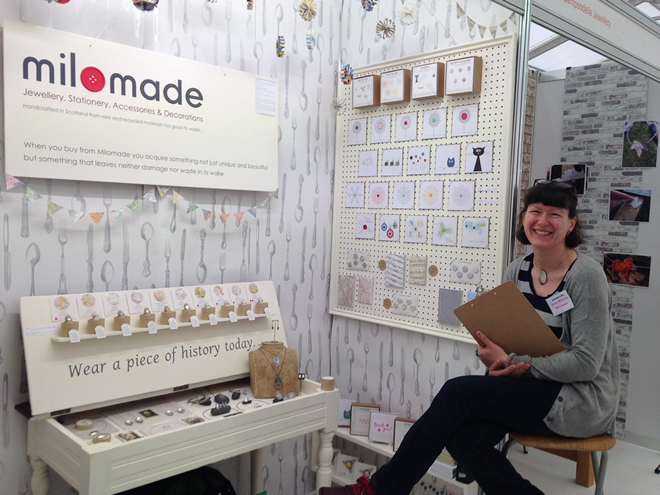
You work with both rare and recycled materials, why take this approach?
Since Milomade’s infancy I have always focused on recycling and working with recycled materials. As my upbringing was very much embroiled in reusing and recycling, it’s no surprise that I’ve grown up following the same principles. I’ve always been passionate about not wasting things. I prefer to do my research and spend a little bit more to buy things that are going to last rather than adopt the modern approach of replacing items regularly and following the latest trends. Trends and fashion don’t interest me at all. Quality does.

That’s how my motto of ‘Too good to waste…’ came about. My entire product range is made from rare and recycled materials: antique silverware, copper pipes, vintage maps/music, and buttons to name but a few. So many of my products evoke the nostalgia of our childhoods, from the comics we used to read, to the maps used to plot our family journeys and holidays. All these items had adventures, over many years before finding their way to my cliffside studio to be lovingly re-fashioned into something shiny and new and ready for a new story.
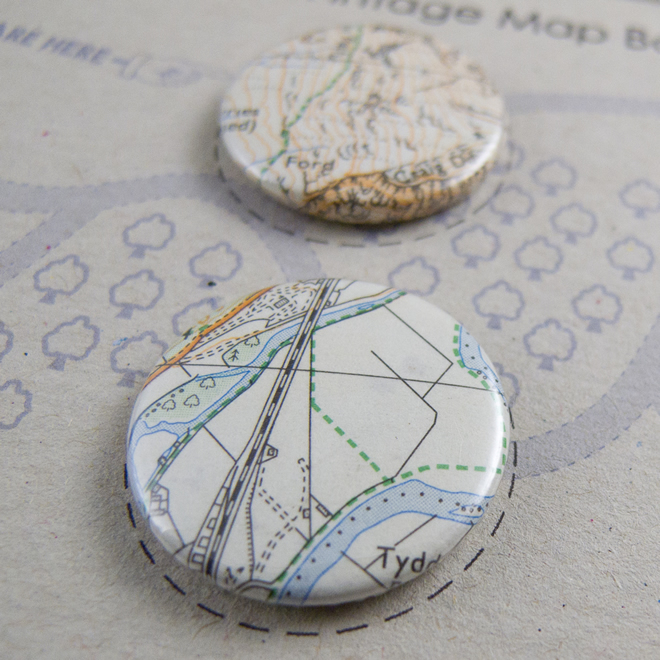
I take old, discarded, unwanted things and re-imagine them and make them new – it’s like turning trash into treasure. I’m a bit of an alchemist in that respect. Where some people see rubbish, I see potential for being creative.
I’m the local recycling place for Christmas Cards in my village and the cards that people donate are transformed into beautiful decorations that can be bought direct from my studio when I’m open to the public at Christmas. I also make DIY packs that contain all the ingredients to make the same 3D baubles, paper bunting and paper flower decorations – so I have a huge stash of vintage maps, sheet music and shelves full of old children’s annuals. They get used to make my decorations but also my ranges of notepads and badges.
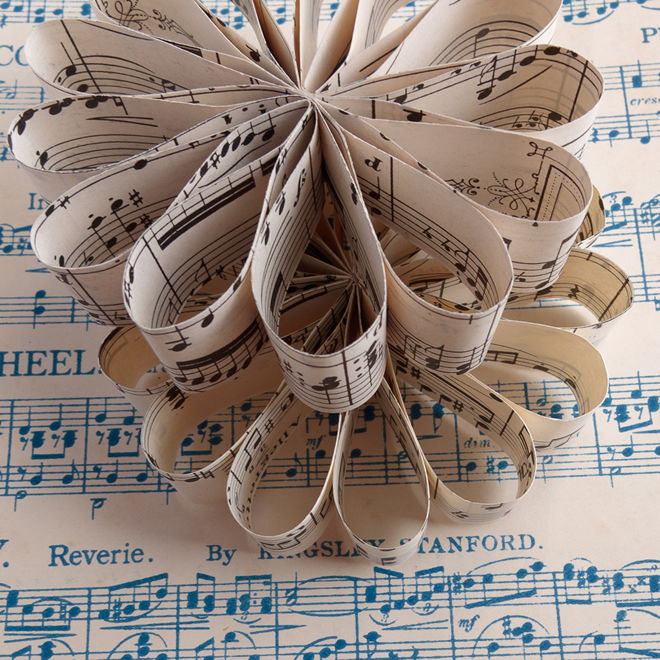
In the early days of Milomade I didn’t use precious metals to create my jewellery, instead I got creative with vintage buttons and recycled beads.
As my interest in jewellery grew I took some one to one classes with a professional jeweller and through this process I learnt the basics of jewellery making using precious and non-precious metals. I followed this tuition with several years of night classes and lots of self-tuition too.
As I started to work with sterling silver, my conscience got the better of me and I wondered how I could continue doing something I loved and not use up the world’s precious resources. I didn’t feel comfortable with buying in new silver and I started adapting my designs so that I could use the least amount of silver possible. Then one day whilst searching for some furniture in an antique store I stumbled across a box of antique silver spoons. I didn’t know much about hallmarks then, so trusted the seller and bought them on a whim.
This started a lifelong passion for antique silverware. Salvaged silver is rare and I have become expert in spotting it, looking out for different items but mostly sterling silver teaspoons. Silver spoons now form the basis of my three main jewellery collections and I mix this vintage silver with Eco Silver to ensure my jewellery is all made from recycled silver.
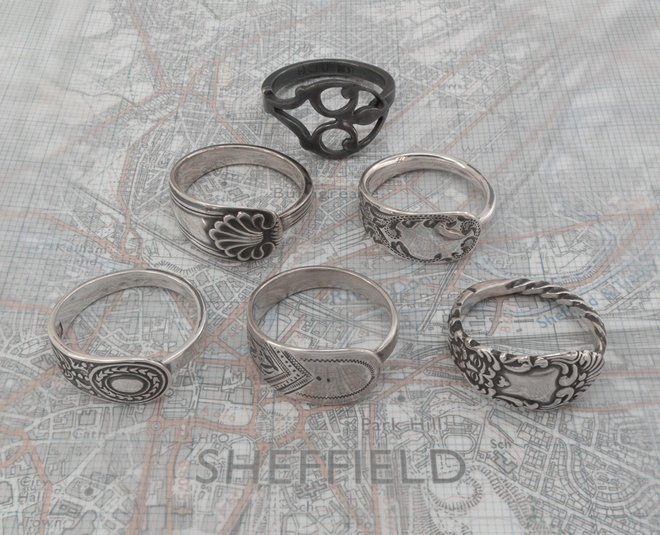
My three jewellery collections all use antique silver teaspoons as a starting point and take this raw material on three entirely different journeys. Nothing is wasted in my making process either and even the silver dust generated from filing is made molten and turned into something beautiful and new.
Discuss the actual silverware you use.
Silverware is a term used to describe objects, principally forks, spoons, sugar tongs and plates, that are used to serve food and are made from sterling silver. Sourcing, restoring and re-purposing antique silverware into unique delicate jewellery is something I really enjoy. There is a sense of history with each piece I make. As I am forming, filing and polishing, I am capturing a memory or an essence of the past. I focus mostly on working with teaspoons and I can’t help but wonder who used to stir their cup of tea with each spoon or how many times each piece of silverware was polished and proudly put on display.
Can you explain the term ‘Eco Silver’?
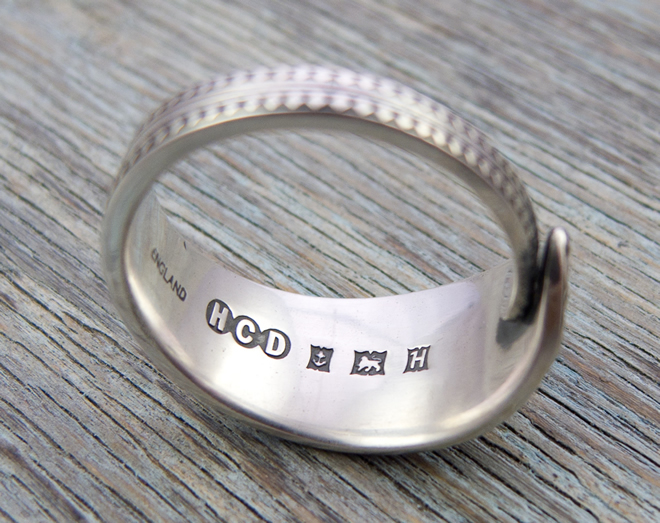
Eco Silver is relatively new, but can be bought as sheet, wire, grain and solder. It’s a green alternative to sterling silver and is made of 100% recycled and scrap silver products like jewellery, medical equipment, electronics and giftware. It can be both treated and worked with in the same way as standard sterling silver, for the same quality results but as it’s more environmentally friendly there’s less weight on my conscience.
Discuss the value of silver marks on the silverware
In Britain, sterling silver is ‘assayed’ or tested to guarantee it satisfies the legal standard requirement for sterling silver (as established by King Henry II apparently) and that it is an alloy of 92.5% silver and 7.5% copper – that why it’s often referred to as .925 sterling silver.
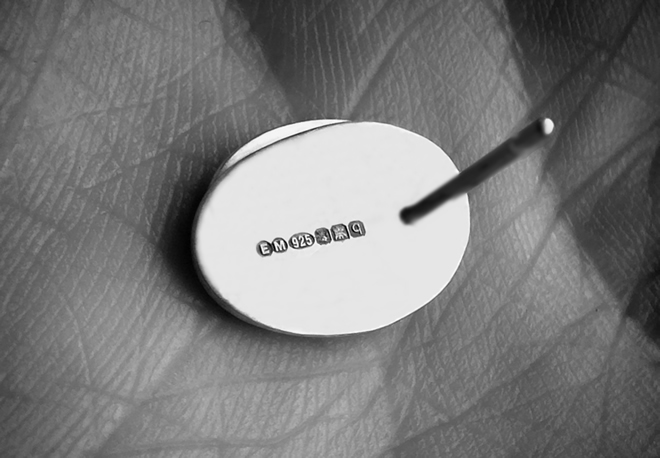
As I want to create pieces to sell and in some instances I want to put my own makers mark on the pieces, it’s important to me that the silverware I buy and work with is .925 sterling silver. So I research the hallmarks thoroughly before I buy.
A hallmark can tell you who made the item, what the item is made from, the Assay Office at which the article was tested and marked and the year in which the item was tested and marked. I registered with the Edinburgh Assay Office as soon as I started working with sterling silver. My own makers mark is made up of my initials ‘E’ and ‘M’ within two separate circles. Every maker working with precious metals registered within the UK has their own unique hallmark. I think it’s important to put your stamp on your own work, even if it’s a tiny pair of earrings.
How do you incorporate the markings into your work? Do you need to remark your jewellery so that it has current markings?
It depends. Take a standard silver teaspoon – the original hallmark is generally found on the stem of the spoon. I make rings from the stems of my teaspoons and see the original hallmark as part of the ring’s story.

It would be illegal or even impossible to put my own makers mark on the rings – if I wanted to do that I would have to erase the original hallmark and I think that would be a great shame. It would take away the historical significance and essence of each ring.
So in the making process, the original hallmark on the teaspoons is retained, as I am simply taking someone else’s design and re-fashioning it into a wearable piece of jewellery. In so doing I’m transforming a dusty neglected heirloom into something someone can wear and cherish and pass onto a new generation. The rings come in small limited editions of 1 to 10 and once they’ve been sold, they’re gone to start a new story. So if you see a design you like, it’s best to snap it up before someone else does. I’ve had a few disappointed customers who’ve come back to my studio to find the design they liked has sold out.
My tagline for this collection is ‘Wear a piece of history today…’ and the beauty of my antique silverware spoon rings is whole package – i.e. the provenance of the original item and the history behind it. Each of my antique silverware spoon rings comes with a provenance tag that explains who the original maker was, where the ring was assayed and also in which year. I also embellish my ring boxes with maps that correspond the city in which the teaspoons were assayed.
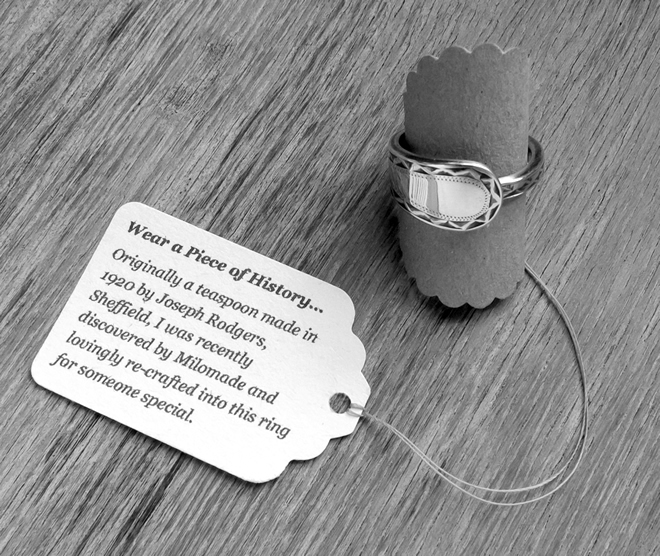
My other two collections made from silver teaspoons do bear my own makers mark as these are made from the bowls of the spoons, cut off in the ring making process. They don’t have any original marks on them and I’m free to do what I like this them and the pieces are all hallmarked for quality at the Edinburgh Assay office.
Uniqueness is a priority in your work discuss this in relation to the buyer?
I’m not a fan of mass production when it comes to jewellery. When I buy jewellery for myself I want it to be unique. I don’t want to wear something that everyone else wears – I’ve always wanted to be different from an early age. These same principles apply just as much today as they did when I was younger and I feel that I’m not alone in this pursuit. With our busy lifestyles and work schedules it’s often easy to fall into making do with mass manufactured goods, but why settle for something mediocre when you can have something magnificent and Milomade!
Each of the jewellery pieces I make is unique. Even though earrings, rings or brooches follow the same design, they are not cast from a mould and instead are all individually made by hand in my studio. I love it when customers visit my studio and looking at pieces in my jewellery cabinet. They choose the pieces that speak to them directly and as everyone is different it’s good to have a selection for people to choose from. I think the individuality of the pieces is a great selling point. It feels like the piece has been made especially for them and I guess I have that in mind whenever I am working.
My Enduring Love collection is a good example. This collection focuses on love, relationships, memories and connections, with a heart at its centre. Each heart design is hand drawn and pierced from the spoon bowl with a delicate jewellers saw, ensuring individuality with each piece. Everyone puts different meanings onto the work – some pieces have three hearts, some two and others just one. These hearts can symbolise family members, lost love ones or the giving of one’s own heart to someone special. Each piece in the collection is beautifully simple and can be gifted to loved ones in the knowledge that each piece is as unique as they are.
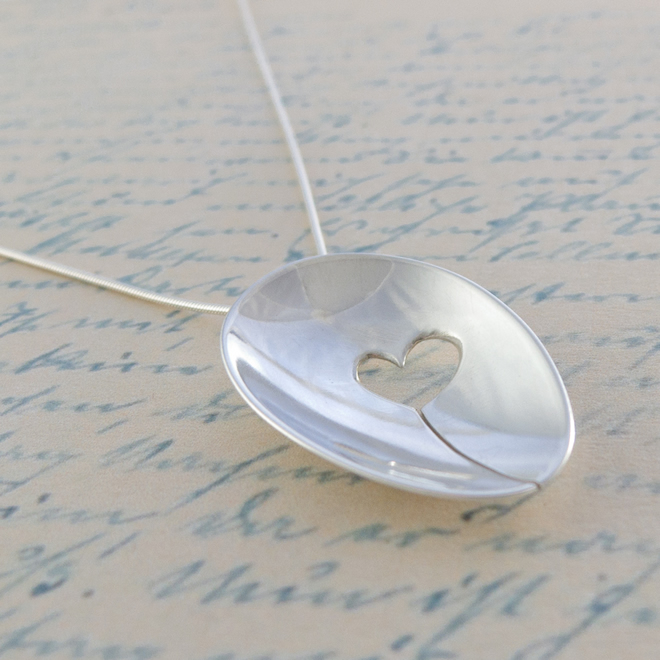
Your ‘Echoes’ Collection is inspired by the coastal landscape and is a joining of past and present, explain what you mean by this joining?
Unlike the Enduring Love collection, where each piece retains the original concave or convex shape of the spoon, my Echoes collection takes the silver on a completely different journey. Here I use the silver as a raw material and at the end of the making process, unless you were told, you wouldn’t really know the pieces were made from antique silver spoons.
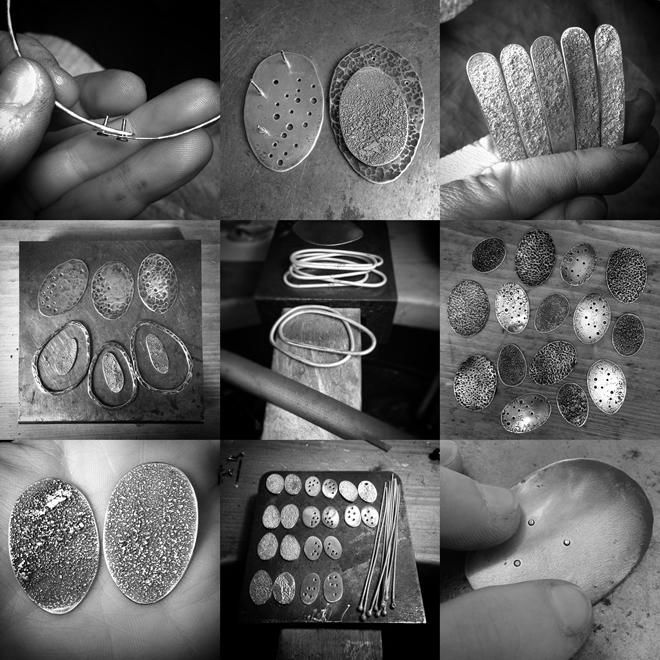
The spoon bowls have to be flattened until smooth before I can work with them and I use traditional jewellery making techniques to texture the metal and join the individual pieces. Some pieces are soldered together, some are riveted and others hang loosely in small bundles – but they all retain an oval shape, which gives a nod to the silver’s past life as a spoon.
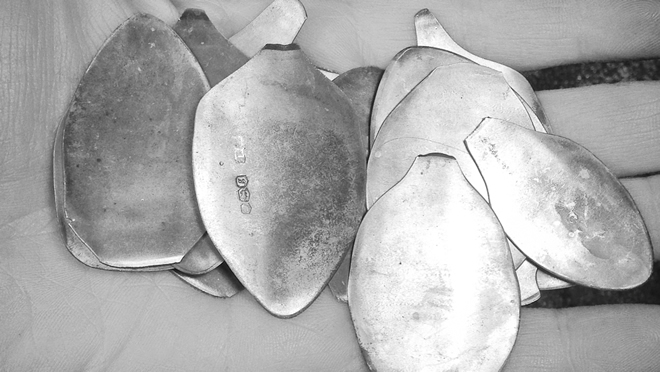
The collection is inspired by the coastal landscape where I live – the textures in the rocks, the patterns in the sand created by the ebb and flow of the tide as well as the ripples and reflections in the water. But the pieces are also about memory and connections with the past. Who hasn’t stood on a beach and looked to the horizon and thought of fond memories or recalled a loved one in a far off land.
I’ve always wanted to live by the sea. I have fond memories of childhood holidays on the southern coast of England breathing in the sea air, visiting lighthouses and hearing foghorns. Something magical got into my blood and I’ve been driven to return to the coast ever since. It’s a joy to be able to walk on the beach every day and have time to reflect. I love picking up pebbles and feeling their textures or letting sand fall through my fingers.
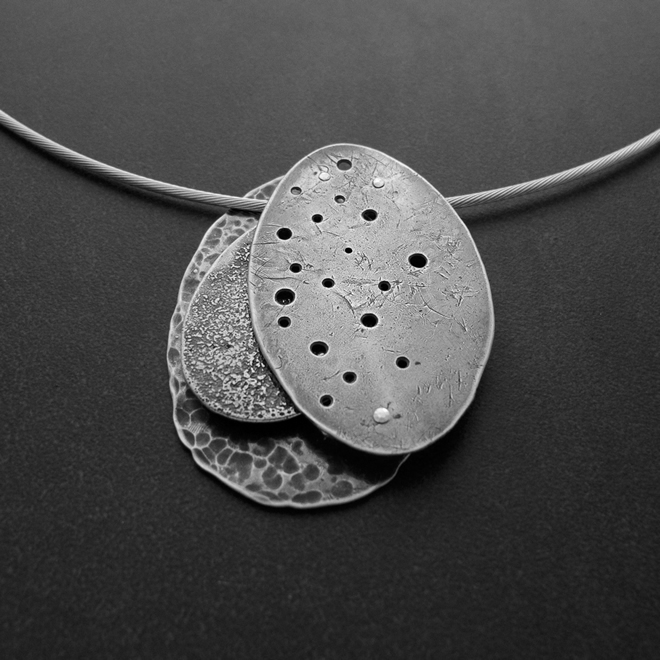
The pieces in my Echoes collection are very tactile and the silver is oxidised (i.e. turned black) and then repolished making the raised parts of the designs shiny, emphasising the different textures within each piece. You often pick up a pebble on a beach and are amazed by how smooth it is and you can’t help but turn it over and over in your hand whilst it’s in your pocket and it forever captures a memory of where you were or who you were with when you found it. It’s that kind of feeling I want to evoke with the pieces in this collection.
Again all the pieces are meticulously handcrafted with individuality and uniqueness in mind. Just like that pebble, each element in the collection has its own personal qualities, textures and details and the pieces all complement each other beautifully.
Not only do you work with recycled silver, is it true that you also make jewellery from copper plumbing pipes?
Yes, it is. I love copper pipes and at the moment it seems that I have an inextinguishable supply. We bought our house 8 years ago and it’s a very old property in need of much love and attention. We did a lot of DIY when we first moved and the two main rooms we renovated were the kitchen and the bathroom – there was a lot of plumbing involved and we ended up with a lot of old copper pipes – we could’ve taken them to the scrap merchant and got cash for them, but I decided to keep them and make jewellery from them instead.
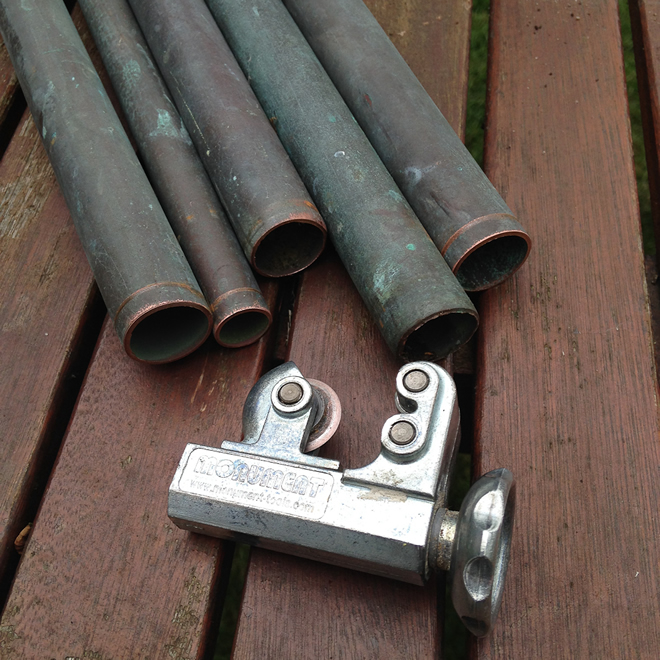
The copper is mostly used to try out new ideas and designs but I also make jewellery from it too. I cut short lengths of pipe and then split it down one side and open it out and flatten it crudely with a hammer. It then gets annealed (heated with a blow torch) which softens the metal and makes it quite malleable. It can then be put through a rolling mill and milled down to the desired thickness and through the process the metal is smoothed and flattened. From that moment on it’s a usable piece of sheet metal.
I lovingly refer to my copper collection as RePlumbed. This collection consists of pendants, brooches and earrings that combine copper, aluminium and silver and all focus around a heart design.
I also make beautiful acorn caps from this recycled copper and combine these with recycled glass beads to make small acorn pendants with oak leaf earrings to match.
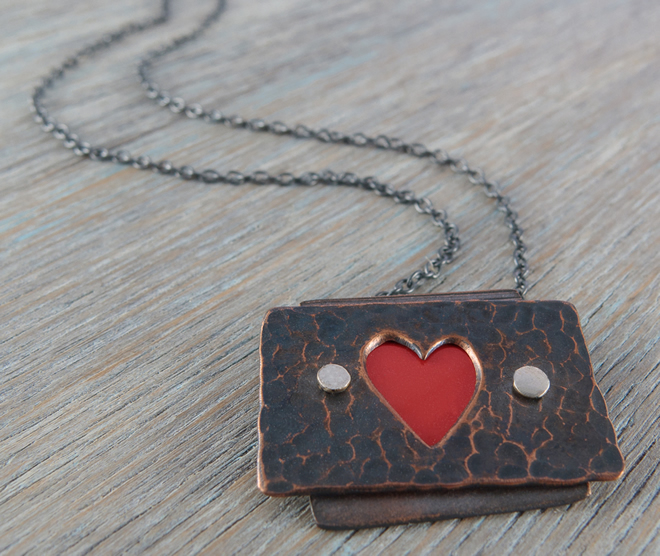
Show us a combination of two or more different recycled objects in one piece.
I love to add colour to my RePlumbed brooches and pendants to bring out the shape of the hearts cut into the designs. This colour comes from aluminium drinks cans and small pieces of the coloured metal are cut and riveted into place between the copper sheets so that the cut out hearts are red. Again, unless you were told, you wouldn’t know that the colour came from a humble can of cola.
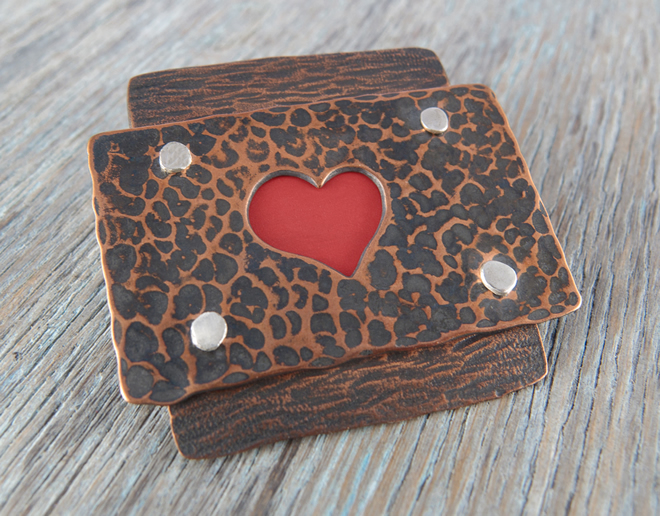
You won an award from Craft Artist Grant Scheme. How did this help your career?
I kick started it! In 2008 I was awarded a grant to set up Milomade from the Craft Artist Grant Scheme available to artists, designers and makers in Fife. I was lucky to be awarded subsequent grants in 2009 and 2010 to build and grow my business. We’re very lucky in this part of Scotland as there are a lot of grants and funding opportunities available for craft and I’ve received funding to help launch my website and online shop, as well as to buy photographic equipment to photograph my work for online sales. I’ve also had funding to buy new tools and materials. Without this financial support I would’ve have really struggled to get my business off the ground.
Tell us about ‘Next Steps’ and how this programme helped you develop Milomade further?
After the birth of my son I felt a little lost with Milomade and needed to do a bit of rethinking and restructuring to move forward. I put some feelers out for help and advice from friends and colleagues. I got some great feedback and advice which all led to me applying for the Next Steps Programme put together by Fife Cultural Trust, Fife Council, Creative Scotland and Fife Contemporary Art & Craft.
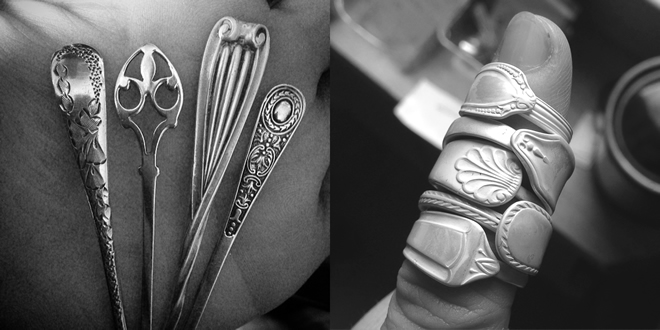
Next Steps is for Fife based craft and visual artists. It’s a tailored support programme that spans 12 months and focuses on personal, professional and creative development and includes 1-1 mentoring as well as funding to help with training, learning new skills, travel and research, buying new equipment and tools etc. In 2013 I applied and in August that year was one of the artists selected for the scheme.
It was a fantastic opportunity and after my first mentoring session I had set the wheels in motion to work towards doing my first ever trade show and start selling my products on a wholesale basis. With the funding I was able to get further mentoring that was more specific to doing trade shows and wholesale. I was also able to take advantage of research opportunities and online training to develop my marketing skills. The programme also funded a few jewellery courses where I received one to one tuition in very specific skills I wanted to learn to develop my product ranges. I was also able to buy some much needed tools that had always been out of my grasp because they were so expensive, but have now made my working processes so much faster and more effective.
I would highly recommend mentoring to anyone working within the craft industry, especially if like me, you work alone. Sometimes you get so blinkered and it’s great to get an objective view on your products and processes to move forward and develop as a maker and business owner. I’ve been very lucky with the mentors I’ve had through the Next Steps programme. Both were very different and challenged me in so many ways. I love a challenge and I often surprised them when I delivered what they’d asked of me and then a heap more on top of that. They really helped me push myself beyond my comfort zone and I don’t think I’d be doing what I’m doing without their help.
You have a wonderful studio, discuss.
Ha Ha – I do have a wonderful studio but most of the time I can’t get into it as it’s such a mess. Over the past few weeks though I’ve decided that enough is enough and I’ve got to sort it all out once and for all. This is the problem when you’re a hoarder of precious things – you end up with so much stuff that you don’t have any room to work. My son loves coming into my studio and he marvels at all my ‘precious things’ in jars and boxes and I want to encourage him to come and work with me, but so many times he can’t as I’m so messy. So one of my very late new years resolutions is to put things away, be tidier and not let my studio get into such a state that we can’t work in it together.
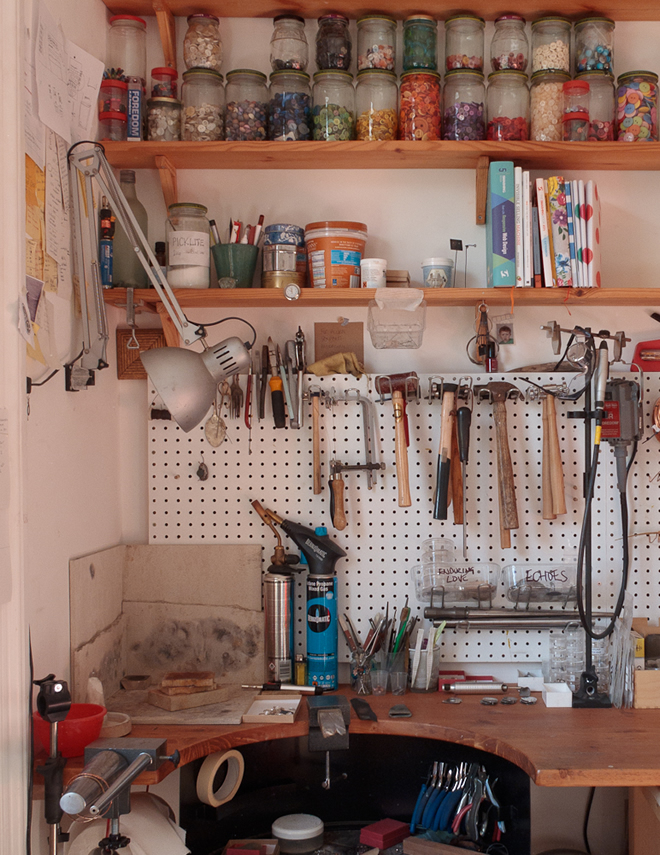
I live in a house on top of a cliff and it’s a wonderful place to be. My studio is a tiny room at the front of our house overlooking the street rather than the sea – I think if I had a sea view I’d never get any work done as it’s mesmerising and changes all the time and because of this you get hypnotised and just stare out of the window for hours.
Despite not having a sea view, I love my small studio and I get beautiful light in the afternoons when the sun moves to the front of the house and I love working in there when the sun is streaming in.
Contact details.
Evie Milo
You can buy direct from my website:
www.milomade.co.uk
Evie Milo, Fife, UK
Interview by Deborah Blakeley, July, 2016
Think a colleague or friend could benefit from this interview?
Knowledge is one of the biggest assets in any business. So why not forward this on to your friends and colleagues so they too can start taking advantage of the insightful information the artist has given?
Other artists you may be interested in:

